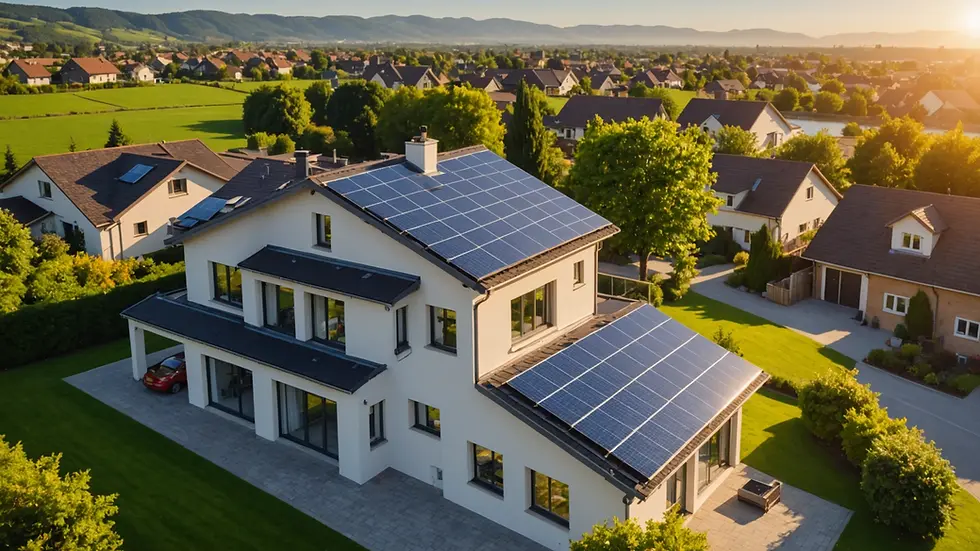Affordable Solar Panels: Finding the Perfect Home Energy Solution for Every Budget
- NY Energy
- Feb 25
- 4 min read
Updated: Mar 10
As renewable energy gains momentum, solar panels are becoming a go-to option for many homeowners. Thanks to technology improvements and a growing consciousness about climate change, solar energy is no longer just for the wealthy. It is an accessible choice for anyone, no matter their budget. This post will guide you through various solar panel options suited to different financial situations, helping you move toward energy independence.
Understanding Solar Panels
Solar panels turn sunlight into electricity, providing a clean and cost-effective energy source for homes. They come in three main types: monocrystalline, polycrystalline, and thin-film. Each type has distinct features and price ranges.
Monocrystalline panels are the most efficient, often converting over 20% of sunlight into electricity. They are space-efficient but usually more expensive.
Polycrystalline panels are generally less costly, with efficiency rates around 15-17%. While these are easier on the wallet, they may require more space due to their lower efficiency.
Thin-film panels offer versatility and can be used on less traditional surfaces, but require about 20% more space to yield the same energy output as their crystalline counterparts.
Understanding these options is vital when considering solar energy for your home.
Budget-Friendly Solar Options
Low-Cost Solar Panel Systems
For homeowners with limited budgets, low-cost solar panel systems can serve as an excellent entry point into solar energy. Companies often offer package deals that include essential components like solar panels, inverters, and installation services without excessive features.
These affordable options can lead to significant savings on monthly energy bills while promoting a greener planet. For instance, many homeowners report reducing their electricity costs by 50% after installing budget solar systems. Additionally, government incentives, such as the federal solar tax credit, can lighten the financial load. Currently, this tax credit allows you to deduct 30% of the installation cost from your taxes.

Mid-Range Solar Energy Solutions
If you can stretch your budget a bit further, consider mid-range solar solutions. These systems generally offer improved efficiency and better warranties. Most mid-range solar panels are made from higher-quality materials and may include advanced features like microinverters or battery storage.
Investing in these systems can increase your energy production by 10-15%, translating to quicker returns through lower energy bills. For instance, a household might save around $1,200 annually with a mid-range system based on average energy costs in the U.S.
Premium Solar Panel Systems
If you have a larger budget, premium solar panel systems are worth the investment. These top-of-the-line systems often feature cutting-edge technology, such as high-efficiency solar panels and integrated battery storage, which offers maximum energy independence.
While premium systems have higher upfront costs, their long-term benefits can be significant. Many of these products come with warranties exceeding 25 years and can increase your home's value by 4-8%. With these systems, homeowners can see energy savings in excess of $2,000 annually, especially as electricity rates continue to rise.

Financing Options for Solar Energy
Finding the right financing for solar panels is crucial for many homeowners. Thankfully, various options are available, allowing everyone to find a suitable plan. Some common financing methods include:
Solar Loans: Designed for solar projects, these loans typically offer lower interest rates than standard loans. They allow homeowners to cover upfront costs and repay the loan over time with the savings generated from their reduced energy bills.
Leases and Power Purchase Agreements (PPAs): In these arrangements, a solar company installs and maintains the solar panels. Homeowners either pay a fixed monthly amount or buy the energy produced at a set rate. This option often requires little or no upfront payment, making it appealing for those reluctant to make a significant initial investment.
Incentives and Tax Credits: Federal, state, and local incentives can dramatically decrease installation costs. For instance, many states have rebates that can cover up to 10% of the installation costs. Additionally, the federal solar tax credit enables you to write off 30% of the installation expenses from your tax bill.
Choosing the Right Plan for Your Needs
Finding the ideal solar solution for your budget requires understanding your energy needs. Conduct a detailed assessment of your home's energy consumption and evaluate whether your roof is suitable for solar panels.
Consulting with a solar expert can offer tailored insights, allowing you to make a well-informed decision based on your financial state and goals. A solid plan will not only fit your budget but also optimize your energy savings and environmental impact.
Embrace Solar Today
Switching to solar energy is an exciting step that brings numerous advantages for your health, property value, and the environment. With plenty of solar panel options available, you can find the right solution for virtually any budget.
From budget-friendly systems to mid-range and premium solutions, embracing solar energy means contributing to a sustainable future. Start your solar journey today and explore how you can save money, gain energy independence, and positively impact the world.
Taking control of your energy costs today leads to a greener tomorrow.




Comments